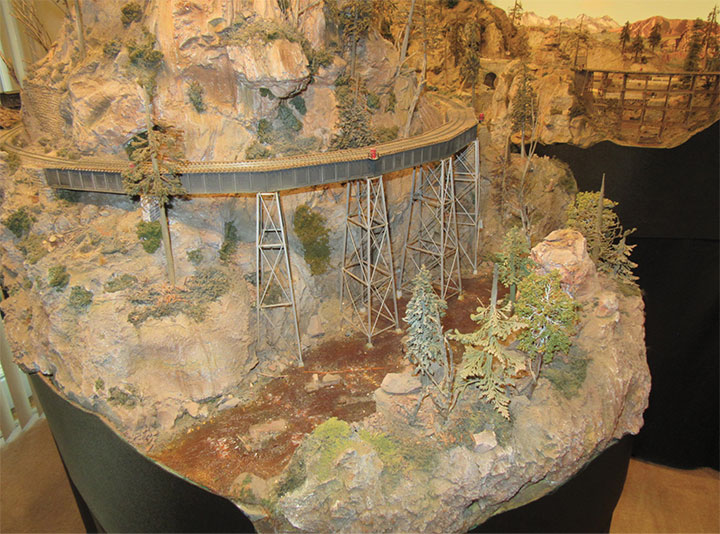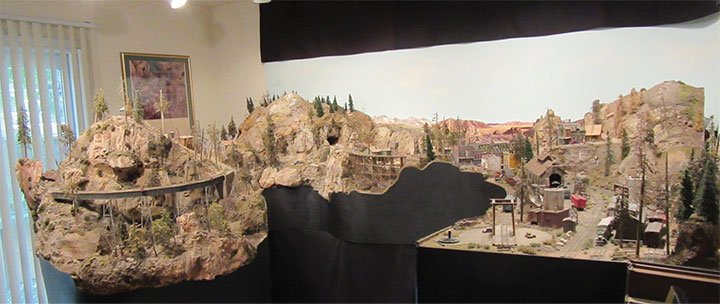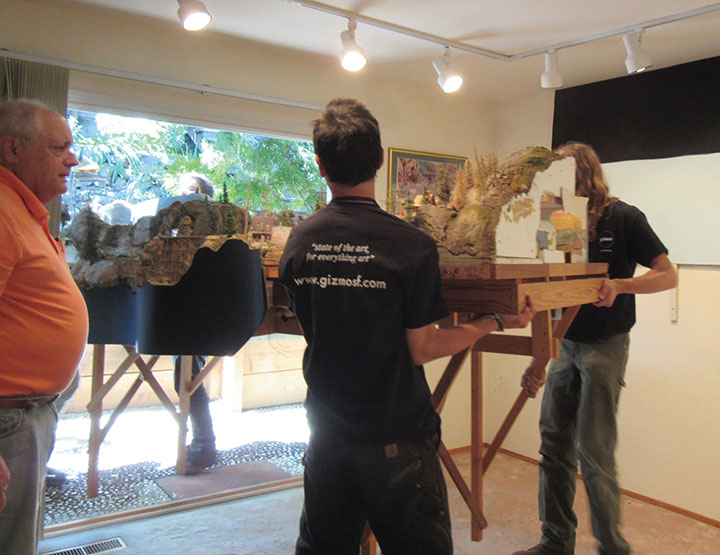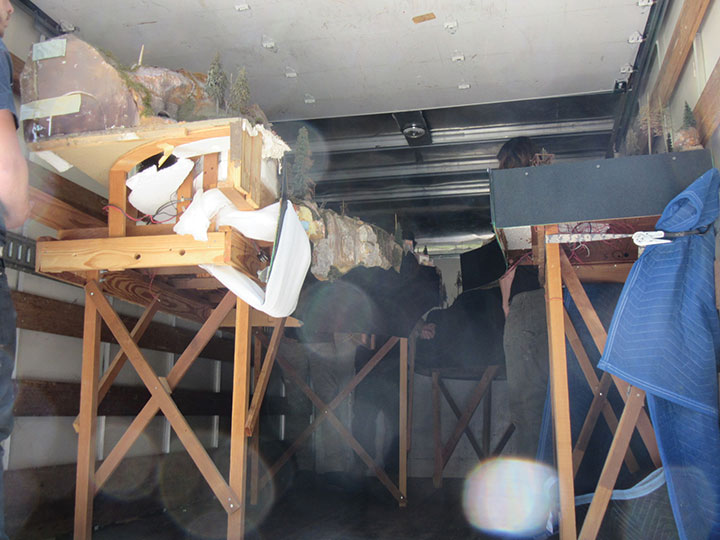Long time readers of the GAZETTE may remember my column way back in the May/June 1998 issue wherein I described how I ended up with Model Railroader magazine’s seminal HOn3 project railroad, the San Juan Central (SJC). This innovative layout, Model Railroader’s only narrow gauge project railroad, was built by Malcolm Furlow and had a large impact on the narrow gauge world. Its construction was described in a series of articles appearing in the November 1983 through August 1984 issues of Model Railroader. So popular was the series that the articles were later published as a soft-cover book entitled HO Narrow Gauge Layout You Can Build, (Kalmbach Publishing Co., 1984). Three printings later, the book went out of print until Bob and Irene Brown, with Kalmbach’s blessing, issued their own expanded version in 2008 as a Benchmark Publications book. Added was a chapter by Bob Hayden, on the “Rest of the Story” about the SJC’s journey through different owners. Starting with Malcolm, I was Owner #5 as related in the book and my earlier column.
The San Juan Central was innovative in many ways. First, it was a complete narrow gauge railroad in only an 8 by 10-foot space. Secondly, its scenery was spectacular and innovative by using a can of expandable foam instead of plaster. It also emphasized the use of readily available plastic structure kits with only a few craftsman kits. In so doing it was a pre-cursor to Ready-to-Run Narrow Gauge. And it introduced an early analog version of DCC just as that technology was beginning to develop. Malcolm is an artist, and the SJC made very good use of vertical spaces to create the illusion of a much larger layout. The Crazy Horse Bridge scene with a rushing mountain stream, crossed by a spindly viaduct amongst steep cliffs, was pure Malcolm. Dramatic and scenically spectacular, but in a small isolated space using Atlas bridge girders and Plastruct shapes over a plywood roadbed, it created the perfect illusion of a spindly viaduct in a river canyon. And all explained in a series of how-to articles that made you feel you could do this.

And many did. Bob Brown and I have visited at least a half-dozen SJC’s over the years at conventions or layout open houses. Many modelers who have visited the SJC at my home, have commented on the positive impact it had on their decision to model in narrow gauge or in the design of their own HOn3 layout. For this reason, back in 1997 when I learned from Bob that the SJC was to be sold by its third owner, I jumped at the chance to obtain it. Not for me, but for its preservation. After all, this was the San Juan Central, not someone’s version, and the thought it might disappear into a personal collection bothered me. Fortunately, the then-owner, James Powell felt the same way and actually turned down an offer for more than the asking price when he learned that I intended to “save” the layout for eventual display.
As the Benchmark Edition of Malcolm’s book noted, the original plan was that the San Juan Central would find a home in the proposed NMRA Howell-Day Scale Model Railroad Museum. Some years later, I formed the Narrow Gauge Preservation Foundation on behalf of Sam Furukawa, and the Board thereof hoped to build a narrow gauge model railroad museum. That became the new intended home for the SJC. Decades passed and neither museum appeared. My long-suffering wife Margaret, who had given up her exercise room to house the SJC, was convinced the SJC, like the Uncle from Toledo, was here to stay.

Not that having the SJC was a burden. You cannot believe the reactions of those who visited expecting to see a Lionel set around a Christmas tree, were shown the SJC instead. Their open-mouthed astonishment was always gratifying to see. One memorable visit by our Congressperson, a very proper lady, elicited an involuntary “Holy F…,” the only time I have heard her swear. Inevitably I would be asked how long it took me to build it. Usually I would laboriously explain its history, often showing the Kalmbach book, but that generally elicited confusion. Eventually I just answered, “about a year,” which is how long Malcolm took. Yes, I felt guilty, but it was a whole lot easier, and I confess to a certain guilty pleasure at being associated with such an impressive accomplishment. And impressive it is. Almost 40 years after it was built, the San Juan Central still impresses. The scenery, as improbable as it may be, is still state of the art.
Malcolm went from Alpine to Desert and back to Alpine scenery in about eight feet. That made creating a collage-commercial backdrop a real challenge. Yet, with its dramatic scenery, clever use of space and well-designed sight lines, the SJC always looked much larger than its modest actual size. Clever staging and use of details enhanced the overall look. By any measure, the SJC was years ahead of its time and hence, still looks good today.
Fast forward ten years, and the NMRA began to plan an exhibit on Scale Model Railroading to be located in a public space as an alternative to the much more expensive and involved museum. In my next column, I hope to be able to update you on this exciting and unprecedented exhibit, which has much to excite narrow gaugers, but for now, back to the travels of the San Juan Central. Once it became clear that #1 — the exhibit was a “GO” and #2 — the exhibit fortuitously would be located relatively close in Sacramento, at the California State Railroad Museum (CSRM), the placement of the SJC in the exhibit became a no-brainer. Bob Brown and I were primary planners and proponents of this exhibit, so from Day One, we incorporated the SJC into the design. Those plans and that design had as many travails and twists as the SJC. Suffice to say, the years slipped by with sometimes little progress to show. For once, the NMRA was not the culprit, but rather the State of California, the economy, and recently, the Covid Pandemic. As months turned into years, I joined Margaret in wondering if the SJC would ever leave our exercise room.
But thanks to Gizmo, our new fabricator, along with the Sibbett Group, the designers and graphics experts, final plans and designs coalesced to the point where in June 2019, we were notified that Gizmo was ready to move the San Juan Central from our home to San Francisco and their studio/workshops where modifications would be made and a cover would be fabricated. Since the SJC was to become an exhibit, safety, ADA compliance and State Museum requirements all had to be met. The Americans with Disabilities Act or ADA compliance was especially painful, though necessary. Malcolm had built the SJC fairly high, about 42 inches off the ground, which was always a problem when children visited. They simply could not see the scenes unless lifted, or a stepstool was placed for them. So, the layout had to be lowered, which impacts its dramatic scenery. But now people in wheelchairs and younger children can enjoy that scenery. So, it all worked out.
Before moving day, I worked very hard to refresh the SJC. Years of sunlight and bright lights had faded the foam and dulled the vibrant colors used by Malcolm. New foam was added, scenery was refreshed, trees were repaired with many added, and overall, the layout was given a thorough cleaning. We found need to do some minor repairs here and there, and not surprisingly, had to re-refresh again in both San Francisco, and later, Sacramento. Sadly, the SJC would never run again, so the wiring Jim Vail, Bob Brown and I worked on when I first set it back up, had to be undone. As reported in the Benchmark book on the SJC, when first reassembled after it arrived, we disconnected the outdated Dynatrol system in favor of straight DC. But it took two MMR’s and me to get the darned thing to run. After much work, we got it to the point where one of Bob Brown’s finely tuned HO Shays could pull a train around the figure 8 mainline. When ex-Kalmbach employee Bob Hayden, who had shepherded the SJC on its one-year Kalmbach Train Show circuit, came for a visit, he was astonished it ran. Only then did I learn that Malcolm had built the SJC for the magazine, not so much to run or operate. Scenery and the final effect trumped electricity and running abilities.
Thereafter, when visitors came to see the SJC, I would nurse a train around the circuit, but always on a wing and a prayer. Reliable it was not. Still to see a train cross the spindly Crazy Horse viaduct was magic. Before the Gizmo crew arrived, I removed all rolling stock and disconnected the three sections. I had to undo three small track bridge sections and break some scenic patches disguising the joints. (These were later restored in Sacramento when the SJC was placed in its final location.) On the appointed day, a Gizmo crew arrived, and first documented everything with photographs and notes. They then carefully lifted the sections out of the double doors and up an external staircase to the street level, and into their rented truck. Once the move started, it went quickly. They also took a box with the rolling stock, an original MDC SJC steam locomotive, and the pair of Grandt Line boxcab Diesels used on the SJC.


Some weeks later, Bob and I were called to San Francisco to review the SJC and fix a few items. We decided on the best way to display it as the “C” shape SJC was difficult to cover while maintaining its immersive nature. You can “walk” into the canyon, a feature we somewhat preserved with a slight indent in the cover, but still ADA compliant. After a second move to the CSRM in Sacramento before the custom cover was lowered, we had one last chance to refresh scenery, fix any details and place trains and rolling stock, held with superglue. California is the land of Earthquakes after all! It was bittersweet seeing it frozen in a moment with an SJC train on the Crazy Horse viaduct while the boxcabs worked shunting cars in the yard. And even in its lowered frozen state, I still think it is darned impressive. Perhaps you will be able to visit the CSRM, amongst the 600,000 visitors the CSRM draws each year, and see the San Juan Central for yourself. Hopefully you will be as impressed as I was when first I saw the SJC in person in my exercise room so many years ago.
Well, that’s all for now; until next time – write, if the mood strikes.
-Charlie